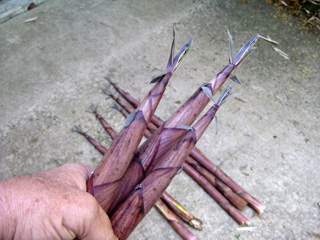Resource Library
Plant of the Week: Bamboo, Timber
Plant of the Week
Timber Bamboo
Latin: Phyllostachys nigra ‘Henon’

These new shoots of Henon bamboo emerge each spring and must be removed to keep the bamboo grove in place. (Image courtesy Gerald Klingaman)
Download High Resolution
I have a live-and-let-live attitude towards gardens and gardening. While I appreciate well maintained and manicured gardens, I will never have one because it goes against the grain of my personality and personal aesthetic. A bit of wild and wooly is ok with me, so long as it doesn’t get completely out of control. My grove of timber bamboo (Phyllostachys nigra ‘Henon”, I think) tests my ability to allow plants to do their thing without completely taking over.
The timber bamboos of the genus Phyllostachys are the most cold hardy and biggest of the ornamental bamboos. These bamboos are woody, forest grasses that are native to China where they have been used extensively in construction and, at least the tender shoots, in cookery. Henon bamboo is top-hardy to about minus 5 degrees Fahrenheit and root hardy to minus 10 degrees. In mild climates with good soil it can reach 40 feet in height with 3- to 3.5-inch culms, or stems, but in my garden where temperatures get to around zero degrees and the planting site is a rocky hillside, the clump only reaches about 25 feet with 2-inch culms.
The timber bamboo grove, which is now about 300 square feet in size and 20 years old, is in an unirrigated part of the garden. My steep, mountainside garden is hardly the kind of terrain typically associated with bamboo plantings but I’ve found that shallow, rocky, droughty soils help keep these rambunctious growers in check. The smaller groundcover bamboos I planted in my Japanese garden behaved very nicely for the first decade but since then have gotten aggressive and their spread needs controlling.
My effort to control spread of the timber bamboo grove began with the selection of the planting site. It is bordered on one side by the driveway and on the other by a 6 foot wide concrete apron drainage ditch. The planting bed is 15 feet wide with no barriers down the length of the bed.
On the shady side of the grove I’ve located my large compost pile, which is filled with oak leaves each fall. Before putting in the fresh leaves in the fall, I spade the year-old leaves to one end of the compost bin and hunt for the bamboo rhizomes which have crept into the pile during the summer. These scary looking, zig-zagged, centipede-like rhizomes are 2 inches in diameter and extend into the pile 6 to 8 feet. These are summarily chopped off and allowed to air dry.
On the sunny side of the grove, I began by digging an open trench down the face of the sloping bed. The trench was about a foot deep, a depth supposedly deep enough to keep the relatively shallow rhizomes confined. It didn’t work. Because the trench tended to fill with soil and organic matter and because my vigilance was not keen enough, rhizomes spread beyond where they were wanted.
Now each spring as the soil warms to about 60 degrees, I begin my annual hunt for newly emerging culms. While breaking off the culms at the ground does nothing to eliminate the rhizome, it does control the size of the grove. I’ve read that new culms stop sprouting when the soil temperature exceeds 70 degrees. I don’t know if it is temperature or soil dryness, but culm production only lasts about four weeks each year. Some years when I’m feeling adventuresome and hungry, I shuck the new shoots down to their edible tip and stir fry them.
They cook up just fine but a more experienced chef could no doubt get a more tasty dish out of the offering.
I do some pruning on the bamboo grove but only when the culms on the edge of the grove are weighted down by ice or snow and droop over the drive. Cutting the top 3 to 6 feet out of the culm lightens the load and usually the culms spring back into place with the fact that they have been topped obscured by the surrounding foliage.
My grove of timber bamboo also needs thinning. I plan to do it this fall when I will remove half of the culms, starting with the smallest and the ones that are leaning the most. Thinning out the stand is both aesthetically pleasing and should slightly slow down the vigor of the clump. The extra room afforded by thinning will also allow new culms to emerge within the grove itself.
Bamboo plantings are not for those with a need for exacting control in the garden.
The bamboo stand suits me and has done what I needed done in that corner of the garden. Some future property owner may call me bad names for planting it, especially if they ignore its unrelenting spread for a few years before they realize it has world domination encoded into its DNA.
By: Gerald Klingaman, retired
Retired Extension Horticulturist - Ornamentals
Extension News - May 23, 2014
The University of Arkansas System Division of Agriculture does not maintain lists of retail outlets where these plants can be purchased. Please check your local nursery or other retail outlets to ask about the availability of these plants for your growing area.